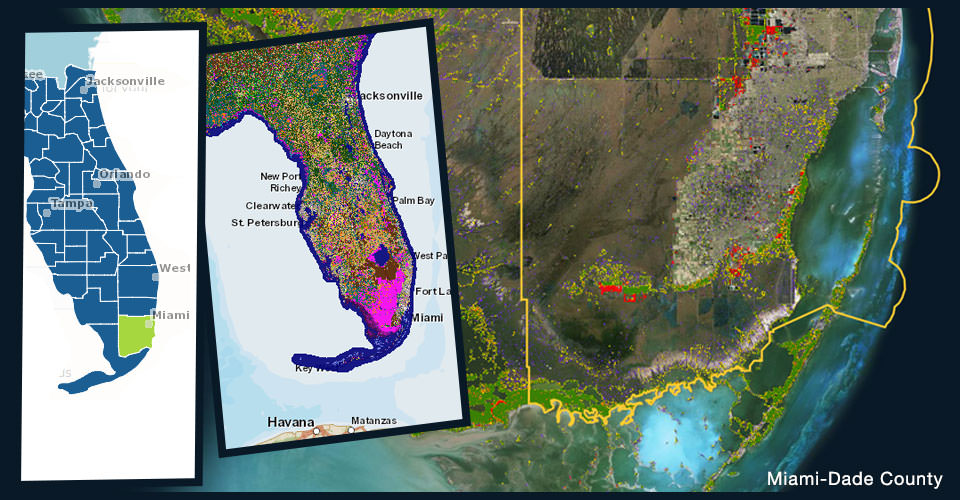Online Atlas Documents Coastal Land Cover Changes Over Time
Development, loss of wetlands, deforestation: see how your coastal county is changing with NOAA's Land Cover Atlas.

Ground Truth
NOAA's Land Cover Atlas is a free online tool that allows users to zoom in on coastal counties—such as Florida's Miami-Dade County shown here—to see how land cover usage is changing over time. Moderate-resolution data on the Land Cover Atlas encompasses the intertidal areas, wetlands, and adjacent uplands of 29 states fronting the oceans and Great Lakes. High-resolution data are available for select locations.
A new NOAA nationwide analysis shows that between 1996 and 2011, 64,975 square miles in coastal regions—an area larger than the state of Wisconsin—experienced changes in land cover, including a decline in wetlands and forest cover with development a major contributing factor.
Overall, 8.2 percent of the nation's ocean and Great Lakes coastal regions experienced these changes. In analysis of the five year period between 2001-2006, coastal areas accounted for 43 percent of all land cover change in the continental U.S. This report identifies a wide variety of land cover changes that can intensify climate change risks, such as loss of coastal barriers to sea level rise and storm surge, and includes environmental data that can help coastal managers improve community resilience.
Among the significant changes were the loss of 1,536 square miles of wetlands, and a decline in total forest cover by 6.1 percent.
Development was a major contributing factor in the decline of both categories of land cover. Wetland loss due to development equals 642 square miles, a disappearance rate averaging 61 football fields lost daily. Forest changes overall totaled 27,515 square miles, equaling West Virginia, Rhode Island and Delaware combined. This total impact, however, was partially offset by reforestation growth. Still, the net forest cover loss was 16,483 square miles.
The findings mirror similar changes in coastal wetland land cover loss reported in the November 2013 report, Status and Trends of Wetlands in the Coastal Watersheds of the Conterminous United States 2004 to 2009, an interagency supported analysis published by the U.S. Fish and Wildlife Service and NOAA.
This new NOAA analysis adds to the 2013 report with more recent data and includes loss of forest cover in an overall larger land area survey. Both wetlands and forest cover are critical to the promotion and protection of coastal habitat for the nation's multi-billion dollar commercial and recreational fishing industries.
Selected Regional Findings – 1996 to 2011
- The Northeast region added more than 1,170 square miles of development, an area larger than Boston, New York City, Philadelphia, Baltimore, and the District of Columbia combined.
- The West Coast region experienced a net loss of 3,200 square miles of forest (4,900 square miles of forests were cut while 1,700 square miles were regrown).
- The Great Lakes was the only region to experience a net wetlands gain (69 square miles), chiefly because drought and lower lake levels changed water features into marsh or sandy beach.
- The Southeast region lost 510 square miles of wetlands, with more than half this number replaced by development.
- Many factors led to the Gulf Coast region's loss of 996 square miles of wetlands, due to land subsidence and erosion, storms, man-made changes, sea level rise, and other factors.
- On a positive note, local restoration activities, such as in Florida's Everglades, and lake-level changes enabled some Gulf Coast and Southeast region communities to gain modest-sized wetland areas, although such gains did not make up for the larger regional wetland losses.
Search Our Posts
Get Social
More Information
Did you know?
Standardized NOAA maps allow scientists to compare maps from different regions and maps from the same place but from different years, providing easily accessible data that are critically important to scientists, managers, and city planners as the U.S. population along the coastline continues to grow. Explore NOAA's Land Cover Atlas
